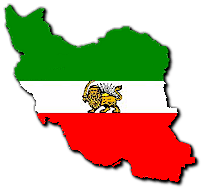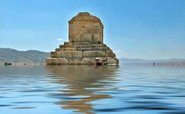- ::::جنایت زیست محیطی در زاینده رود::::::::::

متاسفانه عکسها و توضیحات آن به اندازه کافی گویاست ! در ادامه مطلب ببینید...

در این کانال فاضلاب شهر "بهارستان" که در 15 کیلومتری شهر اصفهان قرار دارد جاریست .

این همان کانال است . به نزدیکی کانال فاضلاب و زمینهای کشاورزی توجه کنید !

این کانال بعد از طی 10 کیلومتر به نزدیکی زاینده رود می رسد. اینجا دریاچه فاضلاب است ! تا چشم کار می کرد فاضلاب بود . در منطقه ای که علامتگذاری شده روستایی به نام "گلستانه" قرار دارد.این کانال بین روستاهای "جار" و "گلستانه" در شرق اصفهان قرار دارد.

و سرانجام فاضلاب وارد زاینده رود می شود ...

بله . باور کنید ... فاضلاب وارد زنده رود می شود !

اینجا چند کیلومتر پائین تر از محلی است که فاضلاب وارد آب شده است . حتی این ماهی 4-3 کیلویی هم نتوانسته در برابر آلودگی مقاومت کند.

به رنگ آب توجه کنید . آب ! ببخشید فاضلاب شدیداً بوی بدی داشت

و این ماهی ها . مرگ گسترده ماهی ها چند روز پیش اتفاق افتاده است . مردم محلی می گفتند حجم ماهی های تلف شده چندین تن بوده است !

سطح آب پر بود از ماهی های مرده

و اینجا هم تور هایی برای صید ماهی ! و ماهی هایی که احتمالاً سر سفره ها می آیند !

ماهی های کم جان و آلوده را صید می کردند. البته می گفتند ماهی ها را برای مدتی در استخر نگهداری می کنند و پس از آنکه پاک شدند استفاده می کنند . در راه بازگشت کودکان ماهی فروش در کنار جاده ایستاده بودند !

در گوشه بالای تصویر گله گوسفند قابل مشاهده است .چرخه کامل شد ...

پمب آب را نگاه کنید ! این آب ! ببخشید فاضلاب وارد زمین های کشاورزی می شود و خیار ، سبزی ، گوجه و ... با آن آبیاری ! ببخشید فاضلابیاری می شود.

از آن منطقه خارج شدیم و به طرف شهر اصفهان آمدیم . این کانالی است که قرار است فاضلاب شهرکی که هنوز ساخته نشده را به کجا ببرد ؟! ادامه این کانال به زاینده رود می رسد ...
آنچه که در عکس ها نیامد :
- بوی تعفن کانال فاضلاب تا چندین کیلومتر باعث آزار و ناراحتی مردم می شود . اعتراضات مردم و متعاقب آن وعده های مسئولان طی چند سالی که این کانال ایجاد شده راه به جایی نبرده .
- یکی از کارشناسان خانه بهداشت منطقه از میزان بالای اسهال خونی ، کم خونی ، بیماریهای گوارشی و پوستی سخن می گفت.
- فکر نکنید این مناطقی که عکسشان آمده آخر دنیاست و خیلی از شهر پرت است ! حداکثر فاصله تا شهر اصفهان کمتر از 7-6 دقیقه است ! در 10 کیلومتری این مناطق آپارتمانهای متری بیش از 5 میلیون تومان قرار دارد.
The Strange Science of Summer : By Robert Roy Britt, LiveScience Managing Editor
posted: 19 June 2008 05:43 pm ET
The rise of the sun is seen at a 2,300-year-old structure in Peru, between Tower 1 and Cerro Mucho Malo at the June solstice, 2003, viewed from the western solar observatory. The sunrise position at the solstice has shifted to the right approximately 0.3° from the year 300 BC. Credit: Ivan Ghezzi
Full Size
The rise of the sun is seen at a 2,300-year-old structure in Peru, between Tower 1 and Cerro Mucho Malo at the June solstice, 2003, viewed from the western solar observatory. The sunrise position at the solstice has shifted to the right approximately 0.3° from the year 300 BC.
At 8 pm EDT on June 20th, the Sun will be as far north as it can get from the celestial equator, marking the June solstice.
With 8 inches of hail falling in parts of Nebraska this week and Arizona reaching triple digit temperatures last week, it may seem rather arbitrary to call June 20 the first day of the summer this year, aka the summer solstice. But scientists really do have a reason. t's all about Earth's cockeyed leanings and some celestial configurations that even the ancients understood. Our planet is tilted 23.5 degrees on its spin axis. On June 20 this year (some years it's June 21), the North Pole is pointing toward the sun as much as is possible. magine Earth as an apple sitting on one side of a table, with the stem being the North Pole. Tilt the apple 23.5 degrees so the stem points toward a candle (the sun) at the center of the table. That's summer for the top half of the apple. Now keep the stem pointing in the same direction but move the apple to the other side of the table: Now the stem points away from the candle, and it's winter on the top half of the fruit. he setup at June solstice puts the sun as high in our sky as it can go, yielding the longest day of the year in the Northern Hemisphere. Scientists put the exact moment of the solstice at 8:00 p.m. ET (keep in mind that the sun is always up somewhere, and the gods don't favor the Eastern time zone). As long ago as the fourth century B.C., ancient peoples in the Americas understood enough of this that they could create giant calendars driven by sunlight. They built observatories of stone to mark the solstices and other times important for planting or harvesting crops. Shrines and even tombs were also designed with the sun in mind. The sun comes up each day (except at the poles) because our planet rotates once on its axis every 24 hours or so. It is Earth's tilt, and our 365-day orbit around the sun, that explain much about how our world changes during the year. Seasons: As Earth orbits the sun, the orientation of the planet's axis, in relation to the sun, changes constantly. A quarter of the way around in the orbit, fall sets in. By winter, we'll be on the other side of the sun, with the North Pole pointing away from the sun. That winter solstice, around Dec. 21 each year, will be the Northern Hemisphere's shortest day, and researchers in Antarctica will be basking in 24-hour sunlight. Shifting stars: As we orbit the sun, the part of the night sky that's in our view changes. A given star sets about 4 minutes earlier each night. Over a month, this amounts to two hours. In winter, this all means that we're looking at stars that during the summer were in our daytime sky, overwhelmed of course by the glare of the sun. Since we complete a circle every year, the stars of summer, such as the Big Dipper, are always the stars of summer.
Endless summer: At the North Pole, the sun rises once a year, around March 19. It rises until the summer solstice, then sinks but does not truly set until around Sept. 24. During summer on the top half of Earth, our planet is actually farther from the sun than during winter, a fact owing to our non-circular orbit around the sun. The difference is about 3 million miles (5 million kilometers), and it makes a difference in radiant heat received by the entire Earth of nearly 7 percent. But the difference is more than made up for by the longer days in the Northern Hemisphere summer with the sun higher in the sky. Which brings up a common question: If the June solstice is the longest day of the year, why are the dog days of August typically hotter? It takes a while for the oceans to warm up, and a lot of weather on land is driven by the heat of the oceans.
The Day The Earth Fell Over --How Weather Has Changed --History Planet Earth: A Year in --Pictures

























 اخبار مربوط به زندانیان سیاسی و نقض حقوق بشر
اخبار مربوط به زندانیان سیاسی و نقض حقوق بشر

















 Tulips in Holland
Tulips in Holland












No comments:
Post a Comment